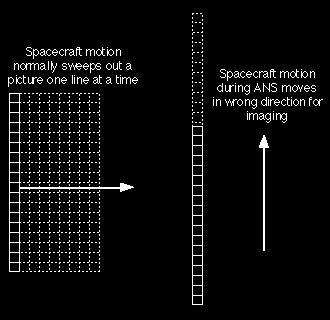

At the same time, the local time on the planet as viewed from the spacecraft will be changing. When MGS arrives, the orbit is nearly co-aligned with the terminator (the transition between sunlit and shadowed portion of the planet), but for each month of aerobraking, the surface position of the orbit slowly shifts with respect to the sun, about 15° of longitude, or about 1 hour of local time, per month. The objective for aerobraking is to arrive at the planned local time (2:00 PM) at the same time the orbit has been circularized. Since the orbit shifts about an hour per month, aerobraking should take about 4 months.
After MGS reaches the correct local time and orbit altitude, there are some other technical issues that must be addressed in establishing the orbit that will be used for the rest of the mission. These involve, among other things, placing the low point of the orbit (periapsis) in the near the south pole, to use the gravitational shape of Mars to help maintain the proper altitude and period for the orbit. These additional factors take about another month and a half, so the mapping mission will not start until mid-March 1998.

During each passage through the upper atmosphere, the spacecraft points the delicate science instruments in the direction away from the motion (the aerobraking attitude). Again, the camera cannot take pictures of Mars in this orientation, since it is always looking away from the planet.
However, after each aerobraking pass, the spacecraft must change its orientation from the aerobraking attitude to ANS. The spacecraft team has designed this transition, called the roll-out maneuver, to rotate the spacecraft around the axis that allows images to be scanned and move the camera axis across the planet. So, once each orbit, there will be an opportunity to take a picture of the planet.
Several factors could reduce the quality of these pictures. First, early in the aerobraking period, the ground beneath the spacecraft is so dark (the orbit is at 5:30 PM local solar time) that the cameras will not be able to see much. This problem has been mitigated somewhat by pointing the camera axis towards the illuminated portion of the planet, but the overall effectiveness of this approach is not known. Second, the focus of the cameras (both the high and low resolution) is sensitive to temperature. Since the temperature of the cameras will vary depending on position in each orbit, and slowly from orbit to orbit, some adjustment for focus will have to be attempted. Unfortunately, without bright stars as a test of focus, this attempt will be subject to considerable uncertainty. Finally, because the timing of each imaging opportunity will only be known to a few minutes accuracy, it is not possible to predict in advance what will be seen in each picture. This could lead to improper exposures (independent of the illumination conditions) that result from intrinsic brightness variations of the ground.
Imaging opportunities end when the spacecraft begins to go behind the planet relative to the sun on each orbit. This is because the spacecraft will then be using battery power to sustain its vital functions for those portions of the orbit, and the science instruments will have to be turned off. This will occur in late November or early December 1997.
The TES is designed to map the surface and atmospheric temperature of Mars, and from those data determine the composition of the ground and the amount of dust and ice in the atmosphere. TES can acquire observations of Mars during the aerobraking orbit because it has a scan mirror that permits it to point perpendicular to the spacecraft ANS motion. Thus, ANS moves the area that TES can see in one direction while the TES's own mirror moves it in a second direction. The TES will construct an image of Mars every time the spacecraft rotates past the planet. This occurs once every 100 minutes, or in the early part of the mission, more than 20 times per orbit. TES will make time-lapse movies of the temperature of the atmosphere and surface, and maps of the composition and rockiness of the ground. As with the camera, the TES will be turned off in late November or early December, when the spacecraft needs to conserve its power.
The Mars Orbiter Laser Altimeter (MOLA) will only have one opportunity to observe Mars before mid-March. During the third close approach to Mars (the second after Mars Orbit Insertion), the spacecraft will point all of the science instruments towards the planet. It can do this safely because it will not yet be close enough to be moving through the atmosphere. At that time, MOLA will be turned on to measure the distance to the planet. Using radio tracking techniques, and working together with the Radio Science team, the MOLA team will transform their measurements of the height of the spacecraft relative to the ground to the height of the ground relative to the center of the planet, that is, to topography. This will be a test of the MOLA system, after which it will be turned off to conserve its laser for use during mapping.
To JPL MGS Home PageContact: info@msss.com